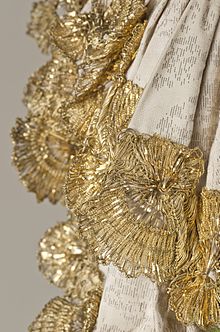Trim (sewing)
This article needs additional citations for verification. (July 2010) |


Trim or trimming in clothing and home decorating is applied ornament, such as gimp, passementerie, ribbon, ruffles, or, as a verb, to apply such ornament.
Before the Industrial Revolution, all trim was made and applied by hand, thus making heavily trimmed furnishings and garments expensive and high-status. Machine-woven trims and sewing machines put these dense trimmings within the reach of even modest dressmakers and home sewers, and an abundance of trimming is a characteristic of mid-Victorian fashion.[1] As a predictable reaction, high fashion came to emphasize exquisiteness of cut and construction over denseness of trimming, and applied trim became a signifier of mass-produced clothing by the 1930s.[2] The iconic braid and gold button trim of the Chanel suit are a notable survival of trim in high fashion.[3]
In home decorating, the 1980s and 1990s saw a fashion for dense, elaborately layered trimmings on upholstered furniture and drapery.[4]
Today, most trimmings are commercially manufactured.[citation needed] Scalamandré is known for elaborate trim for home furnishings, and Wrights is a leading manufacturer of trim for home sewing and crafts.[citation needed] Conso is another leading manufacturer.[5]
See also
[edit]References
[edit]- ^ Tozer, Jane and Sarah Levitt, Fabric of Society: A Century of People and their Clothes 1770-1870, Laura Ashley Press, ISBN 0-9508913-0-4
- ^ Hawes, Elizabeth Fashion is Spinach, Random House, 1938
- ^ "Sewing Standards Reference". Retrieved 10 April 2014.
- ^ "Trims, Tassels & Cording | J&O Fabrics". www.jandofabrics.com. Retrieved 2018-02-05.
- ^ International Directory of Company Histories. Vol. 29. St. James. 1999.
